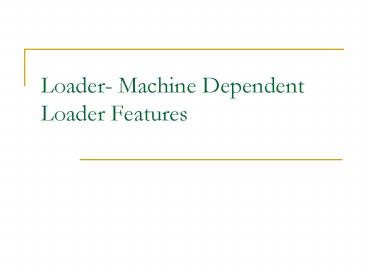Loader- Machine Dependent Loader Features - PowerPoint PPT Presentation
1 / 27
Title:
Loader- Machine Dependent Loader Features
Description:
Loader- Machine Dependent Loader Features Relocating Loaders Motivation Efficient sharing of the machine with larger memory and when several independent programs are ... – PowerPoint PPT presentation
Number of Views:2196
Avg rating:3.0/5.0
Title: Loader- Machine Dependent Loader Features
1
Loader- Machine Dependent Loader Features
2
Relocating Loaders
- Motivation
- Efficient sharing of the machine with larger
memory and when several independent programs are
to be run together - Support the use of subroutine libraries
efficiently - Two methods for specifying relocation
- Modification record (Fig. 3.4, 3.5)
- Relocation bit (Fig. 3.6, 3.7)
- Each instruction is associated with one
relocation bit - These relocation bits in a Text record is
gathered into bit masks
3
Modification Record
- For complex machines
- Also called RLD specification
- Relocation and Linkage Directory
Modification record col 1 M col 2-7 relocation
address col 8-9 length (halfbyte) col 10 flag
(/-) col 11-17 segment name
4
Fig. 3.4
5
Fig. 3.5
6
Relocation Bit
- For simple machines
- Relocation bit
- 0 No modification is necessary
- 1 Modification is needed
- Twelve-bit mask is used in each Text record
- Since each text record contains less than 12
words - Unused words are set to 0
- Any value that is to be modified during
relocation must coincide with one of these 3-byte
segments - e.g. line 210
Text record col 1 T col 2-7 starting address
col 8-9 length (byte) col 10-12 relocation
bits col 13-72 object code
7
Fig. 3.6
8
Fig. 3.7
9
Program Linking
- Goal
- Resolve the problems with EXTREF and EXTDEF from
different control sections (sec 2.3.5) - Example
- Program in Fig. 3.8 and object code in Fig. 3.9
- Use modification records for both relocation and
linking - Address constant
- External reference
10
Fig. 3.8-1
11
Fig. 3.9-1
12
Fig. 3.8-2
13
Fig. 3.9-2
14
Fig. 3.8-3
15
Fig. 3.9-3
16
Program Linking Example
- Fig. 3.10
- Load address for control sections
- PROGA 004000 63
- PROGB 004063 7F
- PROGC 0040E2 51
- Load address for symbols
- LISTA PROGA00404040
- LISTB PROGB006040C3
- LISTC PROGC00304112
- REF4 in PROGA
- ENDA-LISTALISTC1441124126
- T0000540F000014FFFFF600003F000014FFFFC0
- M00005406LISTC
17
Fig. 3.10(a)
18
Fig. 3.10(b)
19
Algorithm and Data Structure
- Two Passes Logic
- Pass 1 Assign addresses to all external symbols
- Pass 2 Perform the actual loading, relocation,
and linking - ESTAB (external symbol table)
20
Pass 1 Program Logic
- Pass 1
- Assign addresses to all external symbols
- Variables Data structures
- PROGADDR (program load address) from OS
- CSADDR (control section address)
- CSLTH (control section length)
- ESTAB
- Fig. 3.11(a)
- Process Define Record
21
Fig. 3.11(a)
22
Pass 2 Program Logic
- Pass 2
- Perform the actual loading, relocation, and
linking - Modification record
- Lookup the symbol in ESTAB
- End record for a main program
- Transfer address
- Fig. 3.11(b)
- Process Text record and Modification record
23
Fig. 3.11(b)
24
Improve Efficiency
- Use local searching instead of multiple searches
of ESTAB for the same symbol - Assign a reference number to each external symbol
- The reference number is used in Modification
records - Implementation
- 01 Control section name
- Other External reference symbols
- Example
- Fig. 3.12
25
Fig. 3.12 (1/3)
26
Fig. 3.12 (2/3)
27
Fig. 3.12 (3/3)

